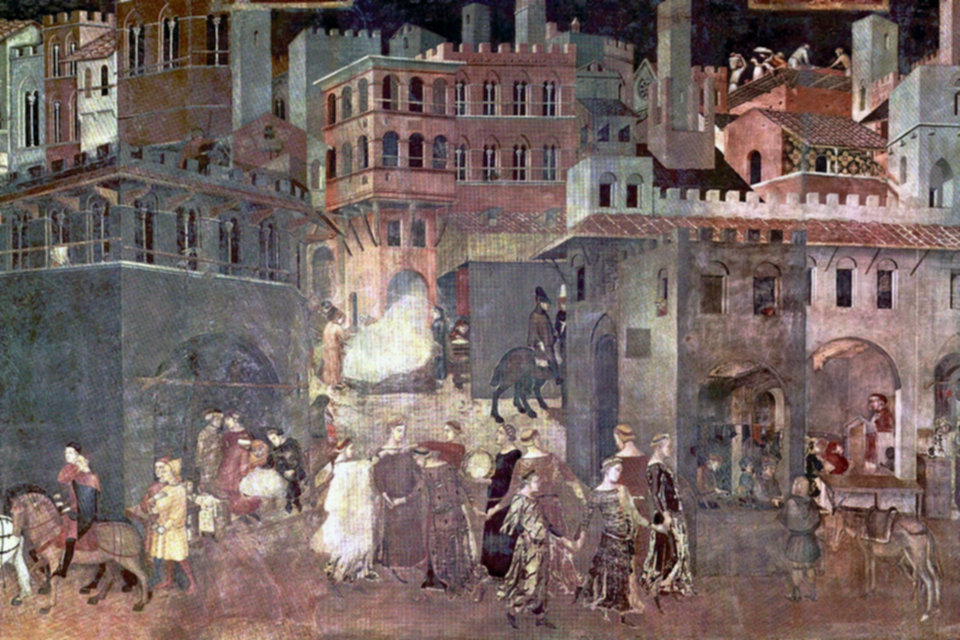A ballade, in classical music since the late 18th century, refers to a setting of a literary ballad, a narrative poem, in the musical tradition of the Lied, or to a one-movement instrumental piece with lyrical and dramatic narrative qualities reminiscent of such a song setting, especially a piano ballad.
Medieval ballad
The medieval ballad on poetic text flourishes in the fourteenth century and has for prominent composers Guillaume de Machaut and Francesco Landini, respectively in France and Italy.
Around 1360 – 1365, polyphonic ballads not intended for dance are written. They originate from the round dance with the solo / chorus alternation: the soloist at the beginning sang the filming or chorus, director of the dance, repeated by the dancing chorus, whence the term shot. There is an example of this dance in the detail of the fresco Effects of Good Government in the city of Ambrogio Lorenzetti: nine maidens hold hands and dance while the tenth accompanies the dance with the tambourine.
Of these works there have been few that have come since they were often improvised; they were probably the Italian equivalent of the French virelai polyphonic. The texts are of a loving nature, where the poet addresses himself directly to the beloved woman. He reached his highest grade with Francesco Landini.
«By faith, talor if perigola!
It is neither sorrow nor mortal spàsemo,
like sença falir cader ne biàsemo,
el ben se tacie and the mal though though it squeaks.
For tru faith talor if perigola!
Lasso the one who never trusted in fémena, who
the love know veneno bitter sémena, so
the death often it is gleaned.
For tru faith talor if perigola!
Alas, that Amor has placed me in this house, so
that every corner there
is the last light, so that it robs my heart.
For tru faith talor if perigola! ”
(Code Rossi: For tru faith talor se perigola)
The musical structure is:
A bba A bba A bba A
where A is the recovery, b are the feet and a is the vault
14 and 15 centuries
In the fourteenth and fifteenth centuries, the French word ballade designated a type of song, usually with three stanzas of seven or eight verses, of which the last served as a refrain. The musical form was the so-called ” bar form ” (AAB): the melody of the first two verses was repeated in the third and fourth; the rest was sung with different melody. The ballades were usually polyphonic, to two or, more frequently, three voices: the upper voice (cantus) was the main melody; the other voices could be sung or played with instruments.
In Italy, in the Trecento (fourteenth century), the term ballata designated a different type of song, similar to the French virelay: a chorus alternated with stanzas divided into two sections: the first repeated twice a melody, with open and closed end; the second was sung with the melody of the chorus.
Ballads in classicism
The German end of the eighteenth century used the term “ballad” to describe folkloric character of narrative poetry (the example of Johann Gottfried Herder), some of which were arranged into songs by composers such as Johann Friedrich Reichart, Carl Friedrich Zeiter and Johan Rudolf Zumsteeg.
Romantic ballades
In late 18th century German literature, the term ballade was used to describe folklike narrative poetry (following Johann Gottfried Herder), some of which was set to music by composers such as Johann Friedrich Reichardt, Carl Friedrich Zelter, and Johann Rudolf Zumsteeg. In the nineteenth century, Robert Schumann and Carl Loewe also composed ballades.
Instrumental ballades
In the 19th century, the title was given by Frédéric Chopin to four important, large-scale piano pieces, the Ballades Nos. 1 to 4, Opp. 23, 38, 47, 52, the first significant application of the term to instrumental music. A number of other composers subsequently used the title for piano pieces, including Johannes Brahms (the third of his Klavierstücke, Op. 118, and the set of four Ballades, Op. 10), Edvard Grieg (Ballade in the Form of Variations, Op. 24, a set of variations), Claude Debussy, Friedrich Baumfelder (for example his Two Ballades, Op. 47, and No. 2 from his Op. 285), Franz Liszt (who wrote two) and Gabriel Fauré (Op. 19, later arranged for piano and orchestra). Ballades for instruments other than the piano have also been written. 20th-century examples of the form include the three ballades of Manolis Kalomiris, the six ballades of Frank Martin (composed for instruments such as the cello, viola, flute, and saxophone), and Einojuhani Rautavaara’s Ballade for Harp and Strings.
Ballads in piano music
Brahms
Four ballads op. 10 (1856)
Ballads and Romances for Two Voices with Piano op. 75 (1878)
Ballad for Piano op. 118, No. 3 (1893)
Chopin
Ballade No. 1 in G minor (Op 23, 1831): inspired by the history of the Lithuanian hero Conrad Wallenrodt
Ballade No. 2 in F major (op. 38, 1839): inspired by the poem “The Swietz” by Adam Mickiewicz
Ballade No. 3 in A flat major (op. 47, 1841): inspired by the “Undine” by Adam Mickiewicz
Ballade No. 4 in F minor (op. 52, 1843): inspired by the Lithuanian legend of the Budry brothers
Liszt
1st Ballad in D flat major (1848)
2nd Ballad in B Minor (1853)
Debussy
Ballad (Slave) F Major (1890)
Ballad
In the mid and late twentieth century, the term ballad began to refer to a type of short composition with lyrics, the latter generally romantic, with slow, slow rhythms.
Since the 20th century the Anglo-Saxon word ballad is used more and more often to indicate, in pop and jazz music, a musical piece played with a slow tempo, in instrumental genre or with a sentimental topic text; an example is the passage Je suis malade by Serge Lama. In traditional music this musical form also identifies songs with more sustained time and with a not necessarily sentimental topic, but with a decided narrative content.
Source from Wikipedia
